Growing plants in a room with north-facing windows can be challenging because such an area gets little or no direct sunlight during the day. As a result, it creates low light conditions unfavorable to many indoor plants. Now, let’s discuss the best north facing window plants.

Are North-facing Windows Bad For Plants?
However, this does not mean you should give up indoor gardening or deprive yourself of greenery in your room because there is a simple solution: choose plants that grow in nature in shady and cool environments out of direct sunlight!
And if you consider that few plants will thrive in such circumstances, you are wrong: the list of plants that prefer bright indirect light from the north-facing windows is far longer than you think!
How to Choose the Right Plants for a North-Facing Window?
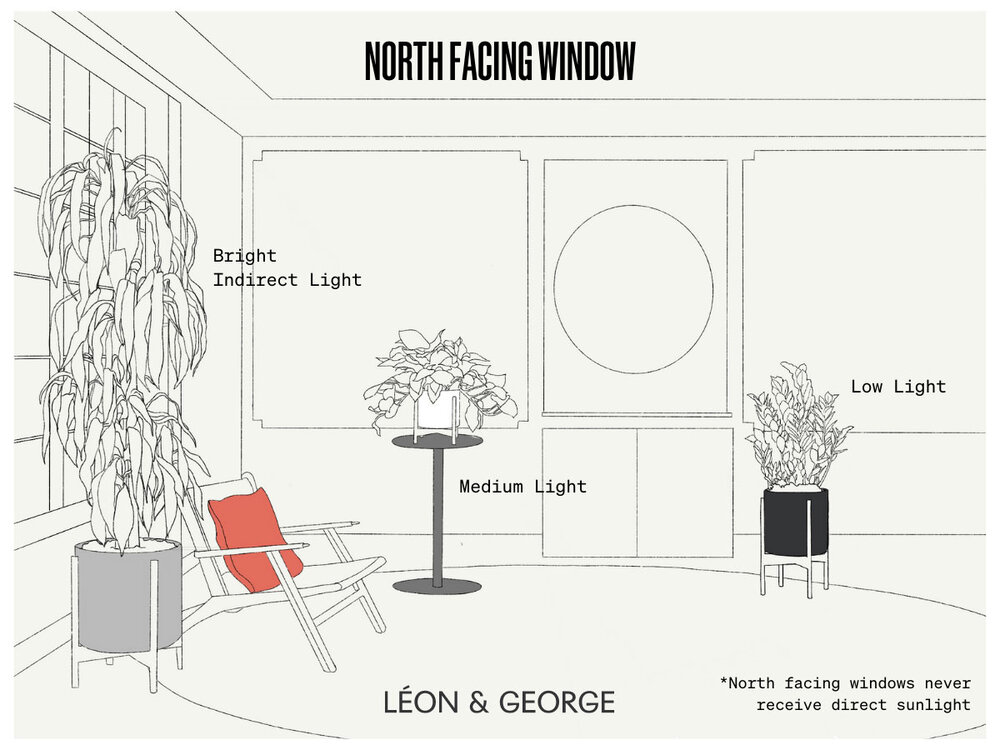
For the successful cultivation of indoor plants, you should try to provide conditions that are partially similar to those in which particular plants grow in natural habitats.
Although all elements of cultivation such as temperature, moisture, soil composition are equally essential, affect plant health and help keep the plant alive, light as a driver of physiological processes in the plant still plays a key role.
Plants that need plenty of bright sunlight to grow may survive in a north-facing window, with indirect light, but the effects of low light will quickly become apparent.
The plants have elongated, thin stems; they twist towards the light source and lose their shape. Furthermore, many variegated species often lose their leaf color.
Therefore, with a few exceptions, for the north-facing window, choose plants with darker green leaves since they contain more chlorophyll, which helps them to withstand low light conditions with fewer consequences.
Humidity and Temperature
The filtered light next to the north-facing window means slow moisture evaporation from the soil and a lower temperature than places exposed to direct sunlight for several hours.
Many houseplants are sensitive to moisture retention, which damages their roots and leads to their decay. Unfortunately, the dynamics of watering can’t help much because it’s not a question of how often you water a plant but how fast the water evaporates.
In addition, less direct sun means a lower temperature, so plants that love high temperatures in such a place will be subcooled regardless of the heating of the space in the winter.
Yet, with all the above limitations that the north-facing window brings, there are still many beautiful low light plants with which you can enrich your space!
Here is our list of indoor plants for north-facing windows that can successfully transform the area with partial shade into a green oasis.
1. ZZ Plant (Zamioculcas Zamiifolia)
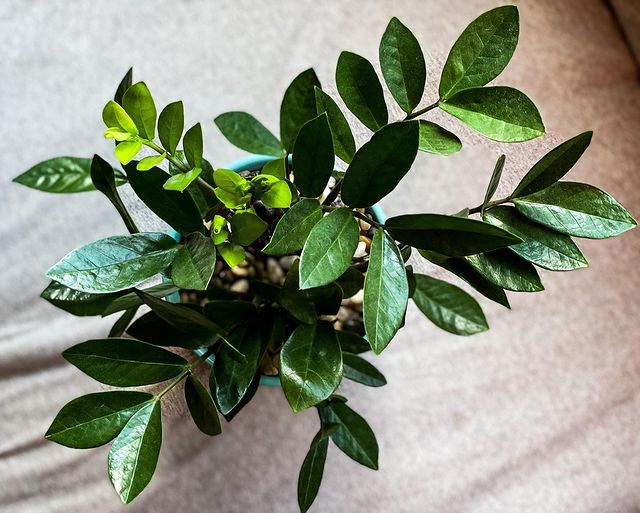
The first on our list of north-facing window plants is Zamioculcas zamiifolia or ZZ plant, a succulent native to Africa. It became an absolute hit at the end of the twentieth century, thanks to Dutch plant growers, who began selling it en masse.
It looks like a fern and a succulent at the same time, and due to its attractive appearance and easy maintenance, it became a common sight in interior decoration. As a result, even many non-succulent lovers have it in their homes.
The mature plants can be up to three feet tall, with several shots in the shape of stems on which there are pairs of shiny, smooth and firm green leaves.
Zamioculcas plants prefer indirect sunlight, and they work great on the north-facing window. Moreover, the leaves lose their dark green color exposed to direct light.
The minimum temperature that this plant tolerates is 59 F, and the optimal temperature is 64 – 75 F.
It would be best if you never overwatered it since excess water can quickly rot its rhizome, and its leaves turn yellow.
2. Begonia Rex (Begonia Rex-cultorum)
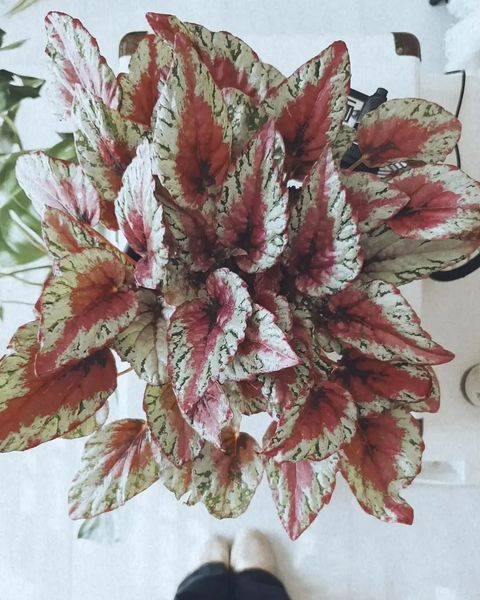
One of the plants that will bring a striking note of intense color to the north-facing window is the small bushy begonia rex or royal begonia.
Begonia rex was discovered in India in the state of Assam, introduced into cultivation in 1850 and was, of course, beautiful: dark green leaves with silvery gray spots. From then until today, thanks to cultivation, hundreds of different hybrids with spectacularly variegated leaves in purple, green, white, crimson shades have appeared.
Leaf shape can be simple, round, oblong, dissected, deeply split, or stellate with serrated or wavy edges. The leaves and stems are covered with thick hairs of various colors. The strands are very short on the leaves’ surface, making the leaves look velvety.
A north-facing window is suitable for Begonia rex for several reasons. First, it likes indirect light and has difficulty tolerating bright light.
Second, slow transpiration allows the substrate to stay wet longer, which also suits this plant. Therefore, do not water it too often, keeping the soil moist, but always let the substrate dry at least two inches deep before watering it again.
And third, Begonia rex does not like high or low temperatures. The winter minimum is around 59 F, and the summer maximum is about 77 F. Therefore, it grows best at a uniform temperature between 64 and 77 F.
And one more thing: avoid wetting the leaves because it is very prone to fungal diseases!
3. Lucky Bamboo Plant (Dracena Sanderiana)

Dracena Sanderiana, Lucky bamboo or Water bamboo, is a beautiful herbaceous plant with a unique, irregular shape that brings greenery and a touch of extravagance to the north-facing windows. Moreover, according to Feng Shui, it brings happiness, prosperity, love, and money to the home.
Lucky bamboo is one of the simplest plants to maintain among all north-facing window plants. It takes minimal effort to thrive. You can keep it in water, in which case you do not have to worry about watering, repotting, or substrate composition. It is enough to replace the water with a fresh one after seven to ten days, and the plant can thrive for years.
From time to time, you can add a few drops of liquid fertilizer to the water, and that’s it!
It is ideal for the north-facing window because it likes indirect light and cooler temperatures. However, too much sun and temperature above 77 F cause the leaves to turn yellow since a room with less than 64 F slows leaf development!
Well, choose three stems for happiness, five for money and six for health, place it on the north-facing window and enjoy watching it grow!
4. Chinese Evergreen Plant (Aglaonema)
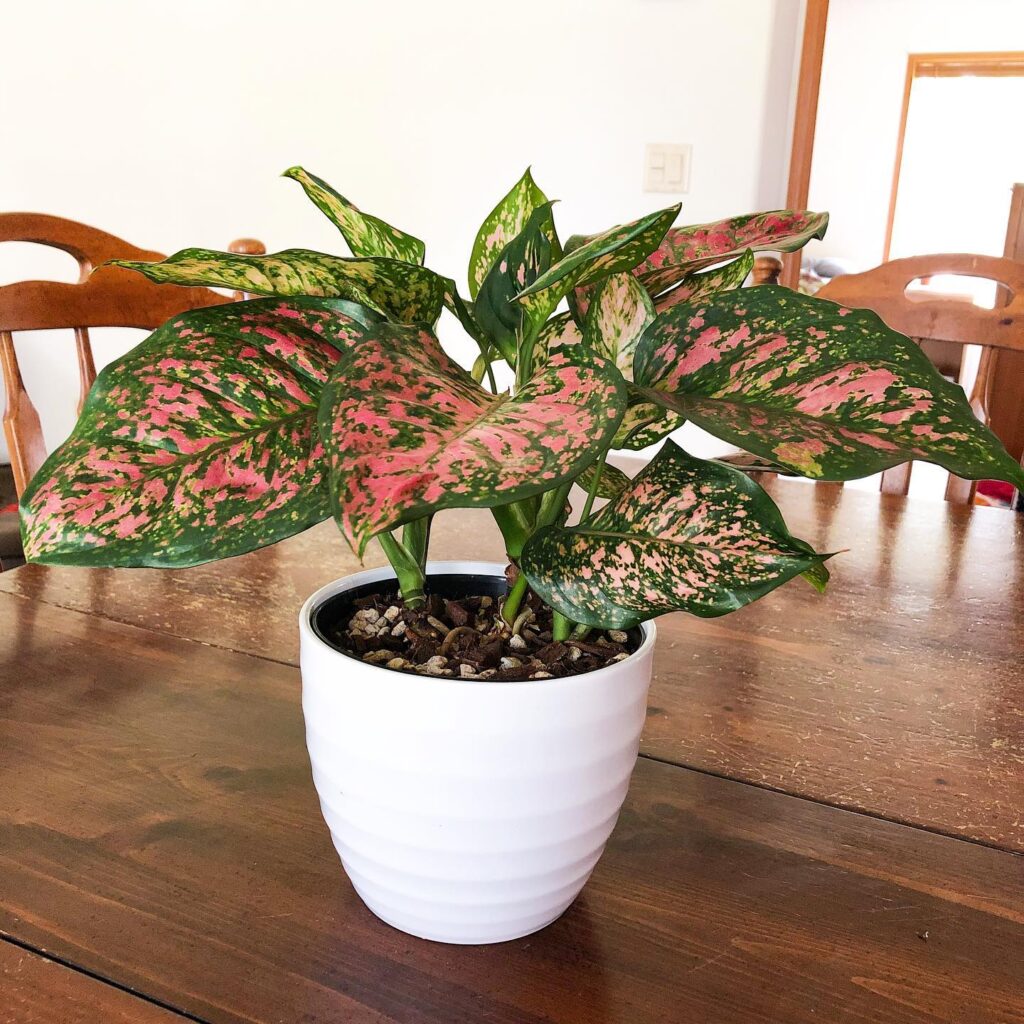
A real gem on our list of north-facing window plants is Aglaonema, or Chinese evergreen, a decorative Asian tropical plant from the Araceae family.
These perennials of the same-named genus are versatile plants and come in various colors, sizes or shapes. They are most often low shrubs that grow up to 15 inches tall, but there are species like A. commutatum that can grow up to three feet and some with a creeping form suitable for growing in a hanging basket.
The leaves grow on long stalks, have entire edges, and they can be differently colored. Chinese evergreen is a dioecious flowering plant, which means that both male and female flowers develop on the same plant. The flowers resemble the calla flower and have the shape of a piston surrounded by large bracts.
Aglaonema is a modest plant that grows well in partial shade and likes the north-facing window. It loves humid and cool environments, so water it abundantly in summer and sparingly in winter when it is resting.
Do not expose it to too low temperatures or dry air and try to provide it with a uniform temperature throughout the year in the range of 64 to 77 F.
5. Prayer Plant (Maranta)
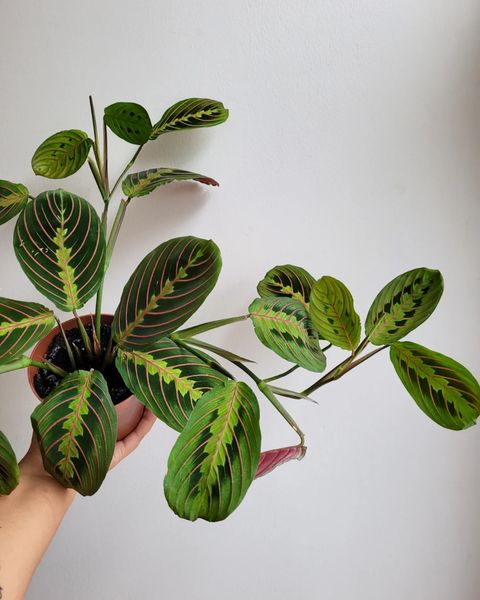
The amazing Maranta or Prayer plant is a tropical plant that feels comfortable in a room with north-facing windows and indirect sunlight. More than four hundred species of this plant grow in nature, usually in filtered light and humid environments.
The most popular houseplant is the tricolor Maranta, which we often see on window sills or hanging baskets.
Apart from the stunning, precise pattern on large ovate leaves intertwined with red veins, Maranta has another property that makes it unique. Namely, its leaves rise and fold as the natural light disappears at the end of the day, so it was named the Prayer plant.
Maranta is not difficult to grow if you provide indirect sunlight, a warm and humid environment and moderately moist soil. It is sensitive to dry air, especially in winter when heated. However, occasional misting or placing the plant on a pebble tray solves the issue quickly.
6. Peace Lilies (Spatifilum)
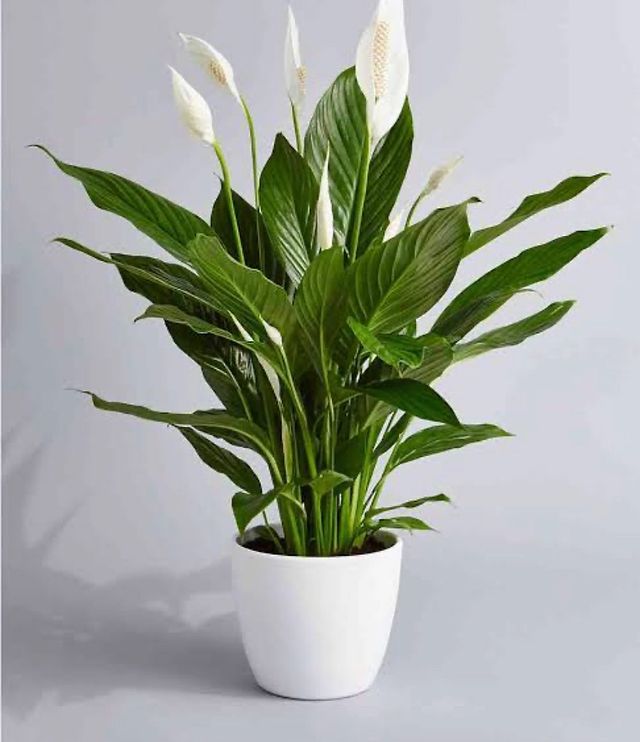
Spatifilum or Peace lily is an elegant evergreen perennial that comes from the rainforests of South America and Indonesia.
This plant has long lanceolate pointed leaves that form a leaf rosette up to 25 inches. During the summer, above the foliage on tall stems appear erect piston-shaped flowers framed by a snow-white bract, which makes a striking contrast to the rich, dark green leaves.
Peace lily does not tolerate direct sunlight, and the delicate dark green leaves prefer partial or complete shade conditions. Therefore, on north-facing windows, this plant will feel at home.
In some parts of the world, the peace lily is called “female happiness” because, according to popular belief, it brings happiness to its female owner.
However, whether you believe in the symbolic power of flowers, the Peace lily is a plant you should have in the house, as it is a successful air purifier.
In addition, Peace lilies are easy to grow and do not require too much effort. However, it requires indirect or filtered light, average room temperature and very high humidity.
Therefore, Peace lilies plants should be sprayed more often, preferably with lukewarm water and in no case with cold tap water.
7. Moth Orchid (Phalaenopsis)
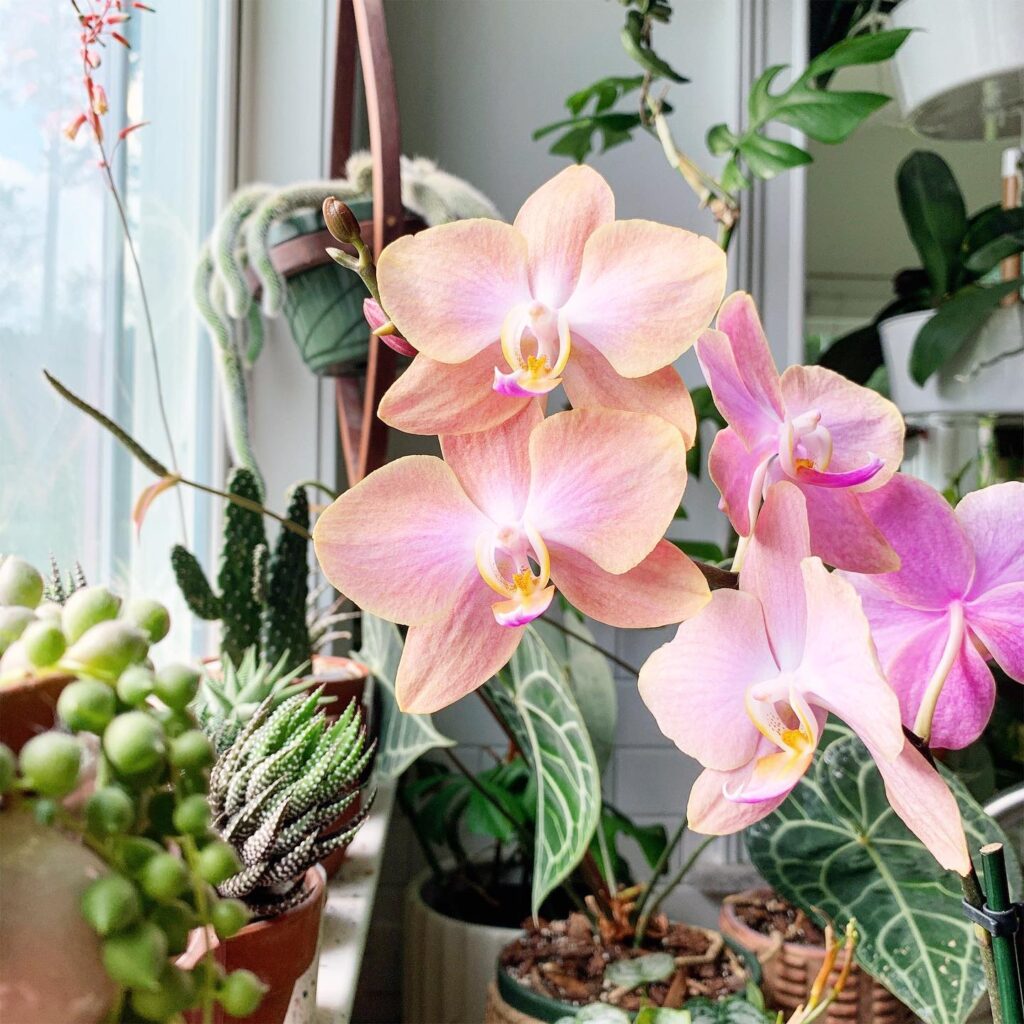
Phalaenopsis or Moth orchids are among the most popular indoor plants because their unrealistic, stunning flowers in the rich opus of colors last a long time and open every few months. Therefore, you can see Moth orchids on the windowsills of almost every apartment or house!
Orchids in their natural habitat grow in the shade, on a tree or tree root, which they use as support. It means that the canopy of the host and other tall vegetation protects it from direct sunlight, making it an ideal candidate for the list of north-facing window plants.
A Moth orchid will last a long time and bloom more often if you provide it with adequate care.
The most important aspect of growing a Moth orchid indoors is proper watering.
These plants come in transparent containers filled with coarsely chopped pieces of bark since it allows you to see when the mixture is dry, and there is no condensed moisture on the walls of the container, which is a sign that it is time for the next watering.
In winter, water your moth orchid only every 15 days, always with lukewarm stagnant water.
8. Spider Plants (Chlorophytum Comosum)
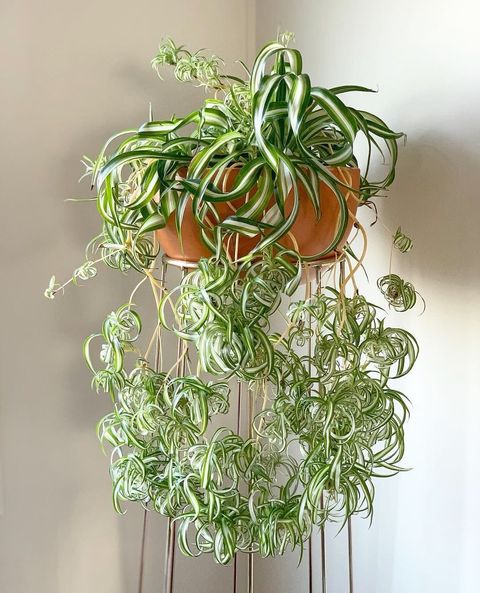
Chlorophytum, Green lily or Spider plant is ideal for beginners because it is a hardy, adaptable plant that is easy to grow. Spider plant originates from South Africa but has long been a domesticated indoor plant in almost all parts of the world.
Thanks to its specific and elongated green or green-white leaves, the spider plant stand out in any space. It looks adorable in a hanging basket, and it thrives in almost all locations, including the bathroom – it is enough to get at least a little light.
Therefore, you can grow Spider plants next to or on the north-facing window because indirect light will not significantly dim the plant’s appearance, color or lushness.
Its tuberous thickened root deposits water to withstand short periods without water.
However, thin leaves have accelerated transpiration, so do not unnecessarily test their durability. Instead, water it once a week in summer and twice a month in winter with small amounts of water.
It is better to hydrate Spider plants more often but with smaller amounts of water since staying in a soggy substrate for too long leads quickly to root rot.
9. Nerve Plant (Fittonia)
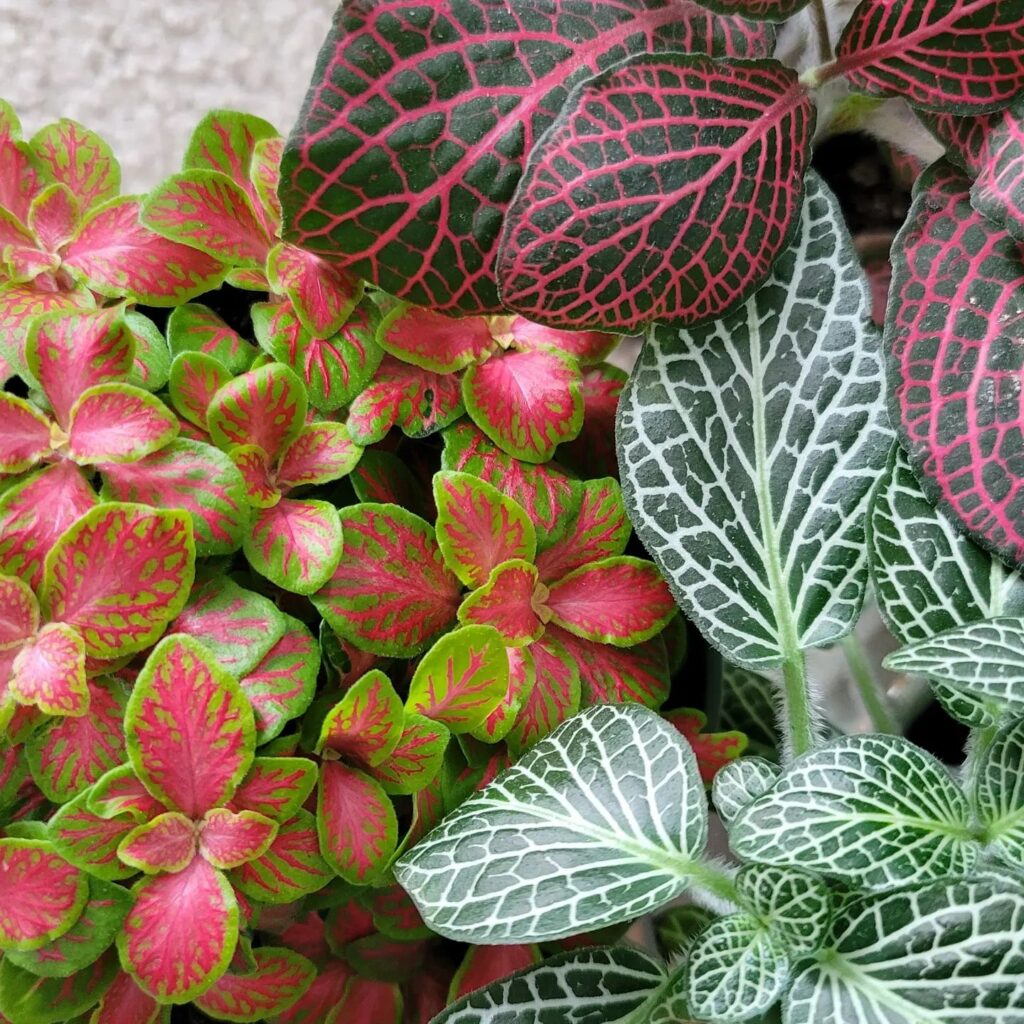
Charming Fittonia, or Nerve plant, is a small window plant from the Acanthaceae family, native to South America. These tropical plants grow as dense ground cover in their homeland, spreading on moist and shady forest soil.
Fittonias got their scientific name after the first textbook on botany authors, the sisters Elizabeth and Sarah Fitton, in the 19th century.
The plants got the name Nerve plant because of the pronounced yellowish-white, pink or red, sacred veins that cross the surface of small, gentle, oval leaves.
The Nerve plant has green leaves and bright nerves, but dozens of cultivars have red, white, silver, pink, or colorful green leaves.
Like many other tropical plants, nerve plants love warm and humid environments with bright indirect light and suffer if direct sunlight reaches the foliage. In addition, it needs a lot of water, so keep the soil moist but not soggy and water as soon as the surface dries.
Although they are flowering plants, the main advantage of Fittonias is their decorative leaves since the flowers are small and inconspicuous.
Due to their modest dimensions and adaptability to low light conditions, Fittonias are excellent north-facing window plants. They do not take up much space but bring a lot of color to your window sill.
10. Cast Iron Plant (Aspidistra Elatior)
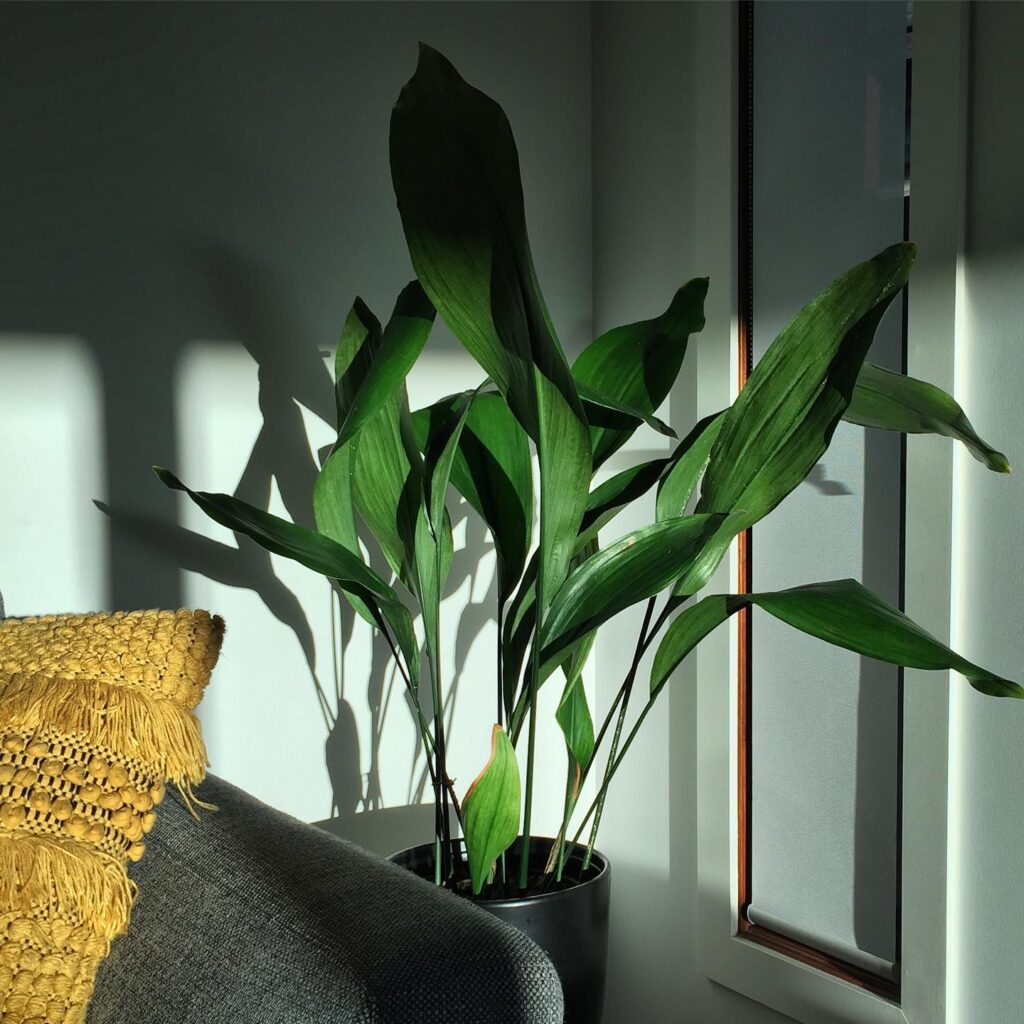
Cast iron plant or Aspidistra is one of the hardy plants without almost any requirements! It can withstand dust, cigarette smoke, changes in temperature, dry air, and grow under fluorescent lights and very dark rooms.
The Cast iron plant originates from the hilly regions of China but is spread worldwide precisely because it thrives even where no other house plants thrive.
These leafy plants have up to 30 inches long and five inches wide, erect or slightly bent, lanceolate, deep green leaves that grow without stems directly from the rhizome root on long stalks forming a dense shrub.
Aspidistra is a flowering plant. The flowers are single, one inch in diameter, dark purple and brown inside. They spring from underground parts, and due to their very short stems, they look like they are lying on the ground.
With its lush growth, the Cast iron plant is an excellent addition to your collection of north-facing window plants because it is bothered by too much light, prefers bright indirect light, but tolerates low light space.
The only thing you need to take care of when growing this plant is to empty its tray after each watering because it is sensitive to water retention around the root system.
11. Aluminum Plant (Pilea Cadierei)
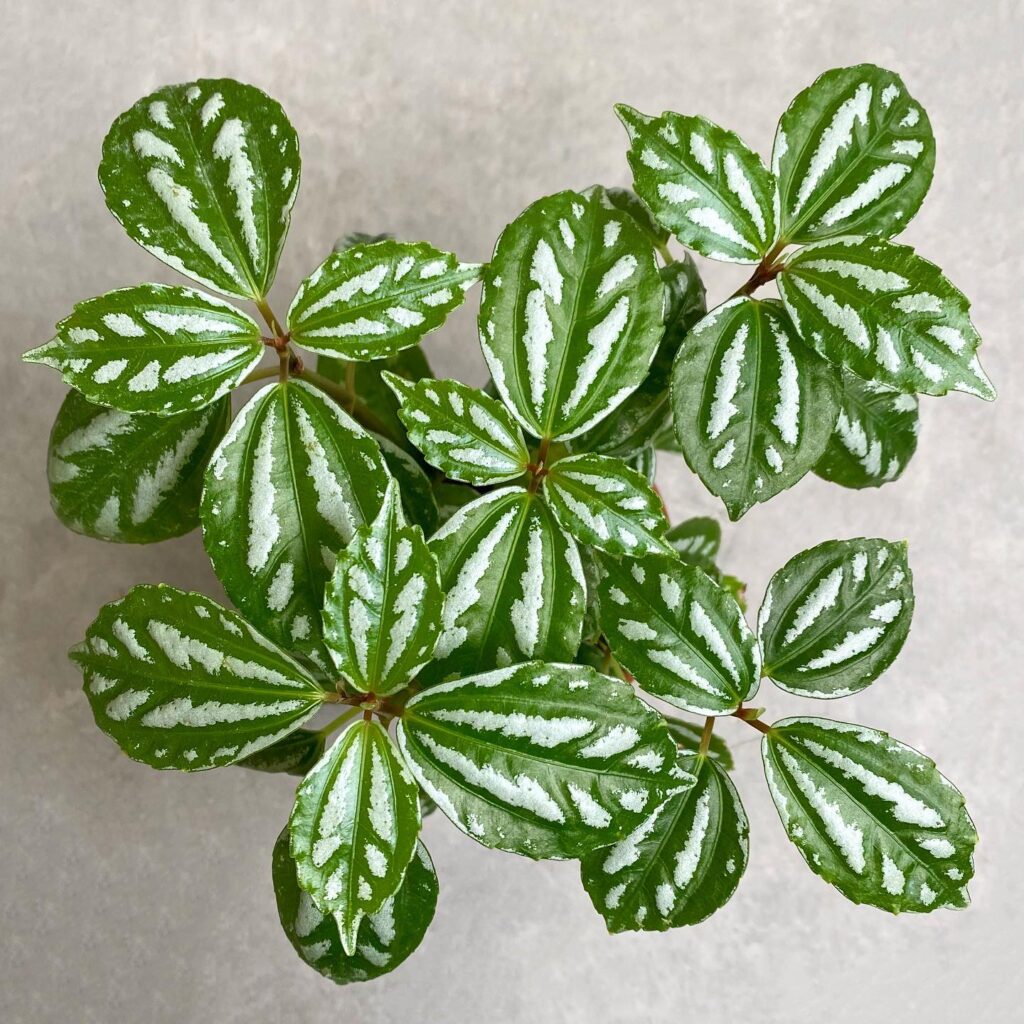
Pilea cadierei, Watermelon pilea or the Aluminum plant, is a small windowsill plant from China and Vietnam that grows up to ten inches in height and, if pruned, forms a dense round bush.
The green leaves, interspersed with silver spots between the leaf veins, have a metallic reflection, explaining the name aluminum plant.
Pilea is not difficult to grow, but it becomes somewhat exhausted and leggy after a few years, and you should not keep it longer than two years. Fortunately, you can propagate it effortlessly, taking cuttings of the top shoots and renewing the plant.
To have a nice bushy look, once a month in the spring and summer, pinch the growing tops, and if you have had it for more than a year in early spring, prune it to a height of five inches.
Aluminum plants need bright indirect sunlight to show the metallic silver foliage shine because direct sun damages the thin leaves. Therefore they will enjoy the east or north-facing window with many filtered, indirect sun.
It likes soil moist and wet, so water it twice a week during the summer and reduce it to once a week in the winter.
12. Swiss Cheese Plant (Monstera Adansonii)
Monstera adansonii is another tropical beauty on our list of north-facing window plants that are easy to handle with low light conditions. It tolerates a wide range of lighting from bright indirect light to middle or low light positions.
Another name for this plant is the Swiss cheese plant because it has characteristic holes in the leaves.
Monstera Adansonii
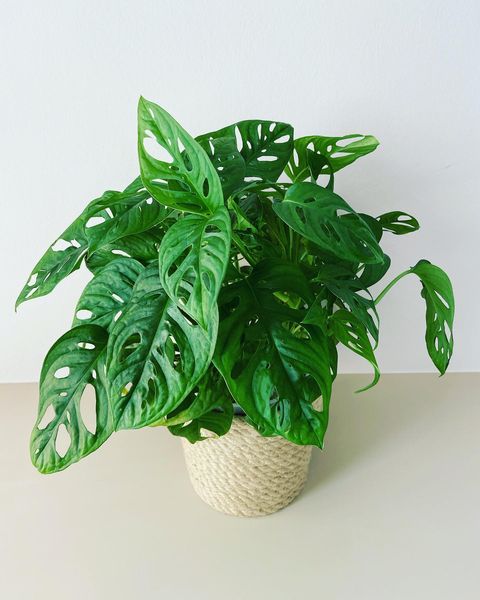
The same name is incorrectly used for its cousin Monstera deliciosa, even though it is a plant with deep slits in the leaves, which does not resemble holes in cheese!

M.Deliciosa
Swiss cheese plant is a lovely creeper that climbs trees in tropical forests, trying to reach the upper brighter parts of the woods.
It can grow along with the support or hang containers as an indoor plant. But, no matter how you grow it, its dark green, oval, perforated leaves always attract attention.
Despite its exotic appearance, the Swiss cheese plant is not a spoiled tropical beauty with many requirements. But, of course, like other plants of similar origin, it likes warm and humid conditions and bright indirect light.
However, water it carefully because the plant likes moisture in the air and not excessively moist substrate. Root rot is most often the result of too frequent watering!
13. Snake Plant (Sansevieria)
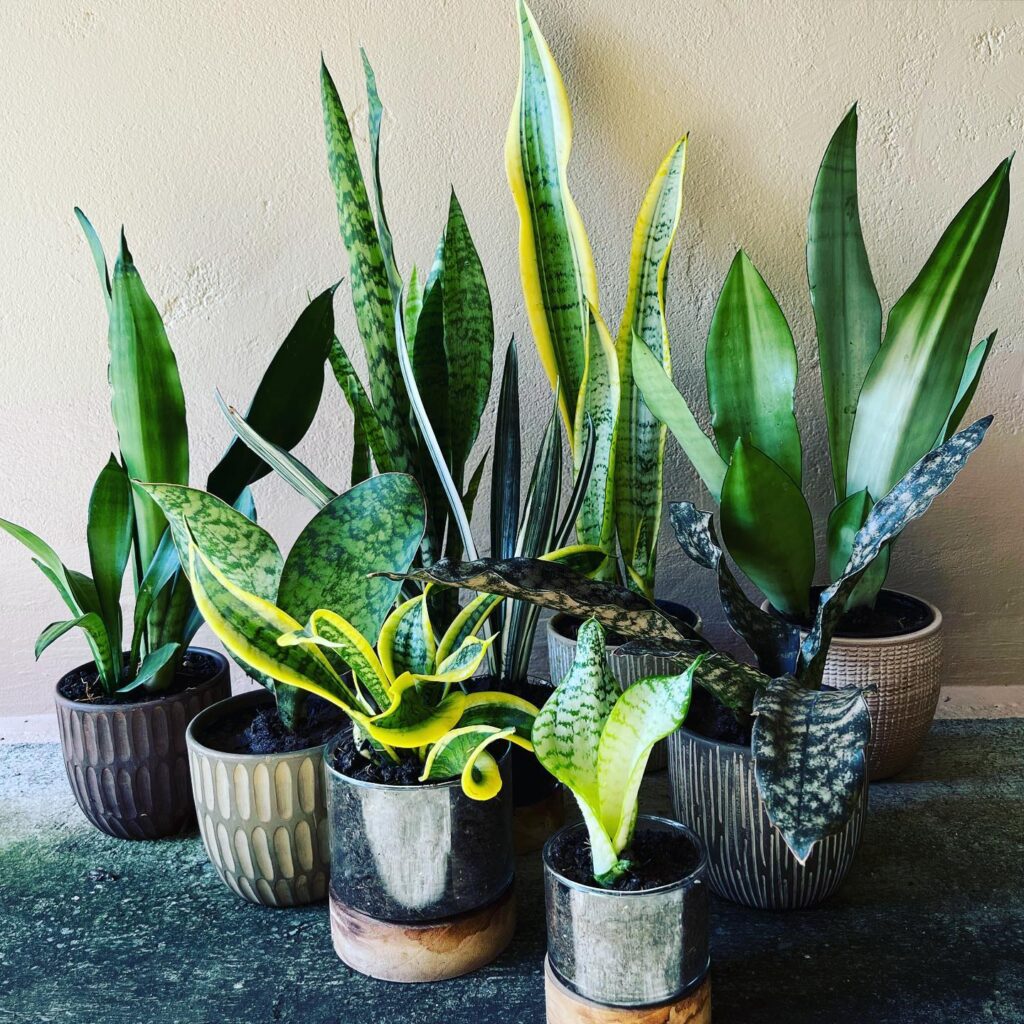
The list of best plants for the north-facing window would not be complete without the Snake plant. These wonderfully hardy plants with fleshy lanceolate leaves without stalks quickly get used to different light levels from bright indirect to low light.
That is why the Snake plant has the reputation of an indestructible, versatile plant because, except for direct light, soaked substrate and humid environment, Snake plants thrive in all other conditions with ease.
Snake plants are diverse plants and come in different forms. For example, some snake plants like S. trifasciata have upright, firm, elongated leaves up to three feet tall, but some species like S.Hanii form low leaf rosettes not taller than 15 inches
But regardless of the variety, the same rule applies to all Snake plants: do not water them often, even in summer, and do not transplant them until the shoots have filled the pot because snake plants are much more productive when their roots do not have much space.
RELATED: How To Propagate A Snake Plant: What You Need To Know
14. Parlor Palm (Chamaedorea Elegans)
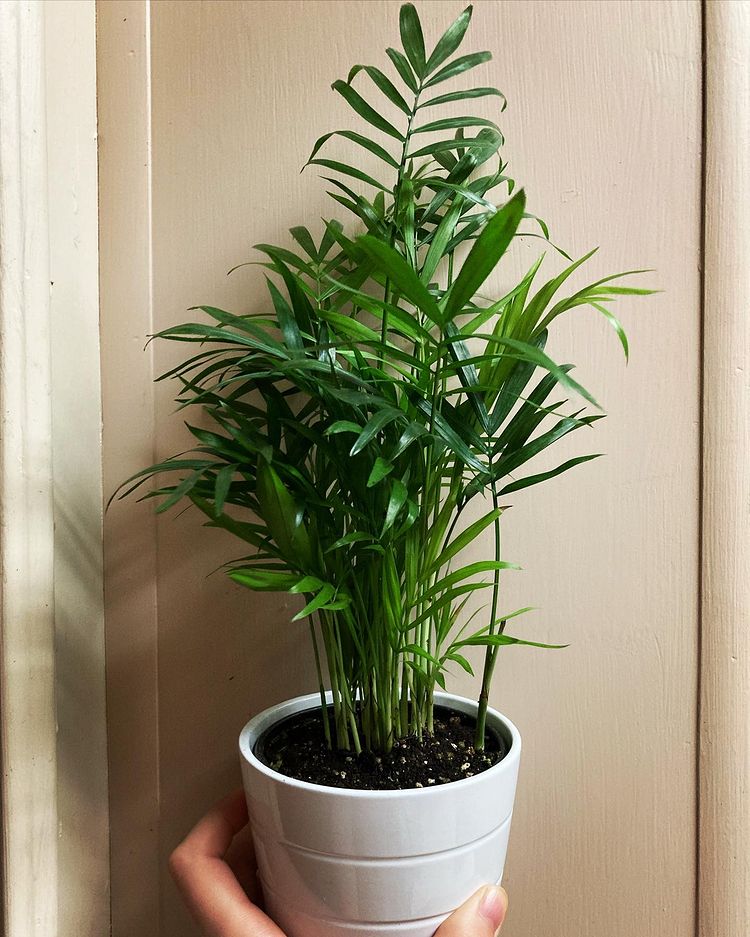
Among the best plants for north-facing windows, a special place holds an exotic parlor palm that, with its feathery leaves, brings a tropical atmosphere to any space.
Originally from the rain forests of southern Mexico and Guatemala, this plant from the Arecaceae family, as potted plants, has been an elegant home decoration since Victorian times.
Parlor palm grows best in indirect sunlight, with elevated moisture levels in the air and permeable soil with little humus and sand.
You can provide extra moisture by spraying the leaves regularly because the standard humidity level of 30-40% at our homes is below 70 or 80% that the palm needs. The first sign of low humidity is the crispy brown tips of the leaves.
15. Golden Pothos (Epipremnum Aureum)

Our best north-facing window plants list ends with golden pothos, a well-known indoor vine from the Araceae family.
Originating from the Far East, Golden pothos or Devil’s ivy has long become one of the most popular houseplants worldwide due to its easy cultivation and very decorative heart-shaped fleshy leaves in vivid green color speckled with yellowish spots.
As a tropical plant, the Golden pothos prefers warm and humid conditions and places where the sun does not come directly on the leaves. So it is to say that it is suited to indirect sunlight as expected from north-facing windows.
During the summer, spray the leaves because the plant loves moist air. Yet, it would be best if you were careful not to drip water on the foliage as excessive water retention causes fungal attacks.
Planting it to have a holder or support for the leaves and stem will be much lusher than creeping Golden pothos.
Frequently Asked Questions
Q: Why do north-facing windows get less sun?
A: The north-facing window is never illuminated by direct sunlight due to the trajectory along which the sun moves. It rises in the east and travels to the west, where it sets, and never faces north directly.
Q: Does a north-facing window mean bright indirect sunlight?
A: Generally, a north-facing window means bright indirect light. However, the brightness of that lighting depends on the environment since, if the window is sheltered by tall trees or other buildings, arched porch, or terrace, bright sunlight will never penetrate the room.
Q: What can I grow on the north-facing windows?
A: In the article, we only mentioned some plants for north-facing windows. Of course, the list is long and includes other low light plants such as Philodendron, Western sword fern, Bromeliads, Boston fern, Peperomia, English Ivy, and many others.
Q: Is a north-facing window suitable for flowering plants?
A: Most flowering plants need a lot of bright light because it stimulates the formation of flowers. However, as mentioned in the article, some window plants can bloom without bright light, like orchids, Cyclamen, Peace lilies or Saintpaulia violets.
Now that you know the best north facing window plants, check out our tips for other window plants to use:
16 Best East Facing Windows Plants – The Stars Of Rising Sun
16 Best West-Facing Window Plants – Afternoon Sun Loving Beauties







